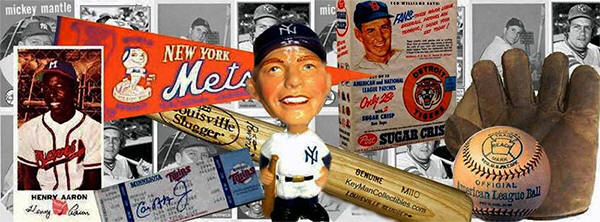|
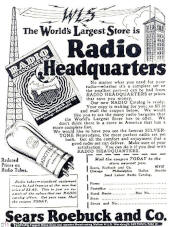 |
|
Sears WLS Radio Station |
|
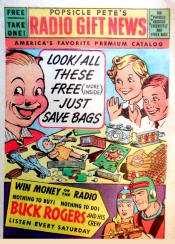 |
Popsicle Pete
Radio Gift News |
|
 |
|
Radio Baseball & Football |
|
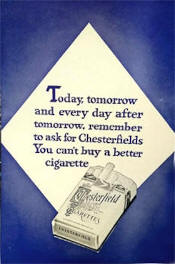 |
|
Back Of Sheet Music |
|
 |
|
1941 Paramount Supplies Distributor Trade catalog |
|
 |
|
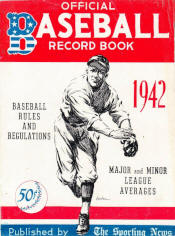 |
|
1942 Baseball Record book standard edition |
|
 |
|
Standard Radio Transcription Services Take Me Out To The
Ball Game DJ Sound Effect |
|
 |
|
1982 The Mickey Mantle Story Stellar Radio Baseball Card
No. 39 |
|
 |
|
Roger Maris-Mickey Mantle Stellar Table Radio |
|
 |
|
1967 Newspaper Ad |
|
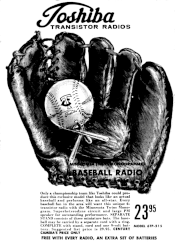 |
|
Minnesota Twins Toshiba SP-515 Baseball Radio |
|
 |
|
Sutton Major League Baseball Team Radios |
|
 |
|
"Learn Not To Burn" Radio Commercial Record |
|
 |
|
WPLJ Radio Salutes The Yankees Pin |
|
 |
|
|
|
|
| KeyMan
Collectibles |
NEWSLETTER |
June 2025 |
|
|
Tuning In On Baseball Related Radio Memorabilia |
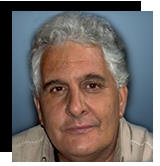 |
|
Steven KeyMan |
|
|
-
By Steven KeyMan |
|
Founder of
Keymancollectibles.com,
and a long time
collector, Steven
KeyMan has more than 30
years of experience in
researching, and
cataloging information
on Baseball
Memorabilia.
Researching his own personal
collection, and helping others find
information on their
collectibles, the
website grew into the
largest online resource
for baseball
memorabilia |
|
|
|
|
|
| |
Ask
Steven: Direct your questions or feedback,
about Baseball Memorabilia to Steven KeyMan
Steve@keymancollectibles.com You can also Send
KeyMan pictures of your personal Memorabilia Display,
and get your own Free
Collectors Showcase Room featured on the website.. |
|
|
|
|
| |
Baseball's first radio broadcast,
was Aug. 5, 1921, from Forbes Field in
Pittsburgh. Harold Arlin was the
announcer on KDKA, the country's first
radio station. Arlin, delivered his
"off the scene" broadcast from a studio
outside the park. There was a rule in
the early days which prohibited direct
broadcasts from the field. So KDKA had
one of its men in a top row of the
bleachers.
 At the end of each inning, the
"reporter" would jot down on paper the
play-by-play then drop his notes over
the fence to a "runner" waiting
outside. The runner would run to the
nearest telephone booth and phone the
information to Arlin at the studio.
At the end of each inning, the
"reporter" would jot down on paper the
play-by-play then drop his notes over
the fence to a "runner" waiting
outside. The runner would run to the
nearest telephone booth and phone the
information to Arlin at the studio.
On October 5, 1921, KDKA and WJZ of Newark broadcast the first World
Series on the radio, between the Giants
and Yankees from a studio. However, the
broadcasters were not actually present
at the game played at the Polo Grounds,
but simply gave reports from a
telegraph wire.
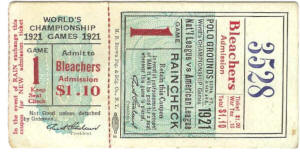 This
ticket stub is from Game 1 of the 1921
World Series, Played on October 5,
between the New York Giants, and
Yankees. Two years before Yankee
Stadium was built, the Yankees shared
the Polo Grounds with the Giants.
This
ticket stub is from Game 1 of the 1921
World Series, Played on October 5,
between the New York Giants, and
Yankees. Two years before Yankee
Stadium was built, the Yankees shared
the Polo Grounds with the Giants.
The entire 1921 World Series was played at the Polo Grounds. It was
the first time ever in World Series
history. Game 1 the Giants were the
home team as they were in every other
game in this eight game series. The
Series was also the last of the
experimental best of nine series, which
the Giants won, five games to three.
 In 1923, Sears, Roebuck and Co. decided
to start up a radio station to address
and target the lucrative farming
market. When the station signed on in
1924 they broadcasted farm reports and
weather information.
In 1923, Sears, Roebuck and Co. decided
to start up a radio station to address
and target the lucrative farming
market. When the station signed on in
1924 they broadcasted farm reports and
weather information.
The station was original assigned the call letters WBBX, and during the
test period they used the call letters
WES (World Economy Store) At the last
minute the change was made to WLS which
stood for 'World's Largest Store.'
The Radio Station used the logo with the Electric Bolt "WLS" lettering, as
it is used on the baseball bats which
were made for Sears by "The maker of
the famous Louisville Slugger Bats."
Sears Roebuck and Co. sold the WLS
radio station in 1928. By that time
they most likely ceased to produce the
WLS baseball bats but continued to
sell the overstock into the 1930's.
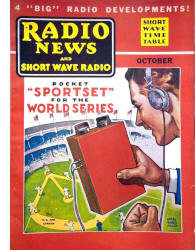 Radio News was a monthly technology
magazine published from 1919 to 1971.
The magazine was published by Teek
Publications Inc. starting with the
September 1931 issue.
The October 1937 issue of Radio News
and Short Wave Radio Magazine, Vol.
XIX feature the cover stories: 4 BIG
Radio Developments and Pocket "Sportset"
For the World Series."
Radio News was a monthly technology
magazine published from 1919 to 1971.
The magazine was published by Teek
Publications Inc. starting with the
September 1931 issue.
The October 1937 issue of Radio News
and Short Wave Radio Magazine, Vol.
XIX feature the cover stories: 4 BIG
Radio Developments and Pocket "Sportset"
For the World Series."
"Sportset" a completely self-contained receiver the size of an ordinary
book, provided headphone reception of
local broadcast stations and was
something that finds many useful
applications such as the World Series.
A receiver so simple that anyone can
build it, and so inexpensive that
anyone can afford it.
The cover illustrates a fan listening in on a radio broadcast of the World
Series on his homemade pocket Sportset,
watching a World Series baseball game
in progress which depicts the famous
Yankee Stadium facade.
 In April of 1939, Karl McCready won the
title of the "Typical American Boy."
Selected by a committee of judges
headed by Dale Carnegie, Karl was in
competition with 25,000 other boys, and
received a lifetime contract to be
"Popsicle Pete," a living Trademark.
In April of 1939, Karl McCready won the
title of the "Typical American Boy."
Selected by a committee of judges
headed by Dale Carnegie, Karl was in
competition with 25,000 other boys, and
received a lifetime contract to be
"Popsicle Pete," a living Trademark.
Popsicle Pete was introduced on the radio program Buck Rogers in the 25th
Century as having won the "Typical
American Boy Contest." The character
told listeners that they could win
presents like this
Popsicle Pete baseball glove with
Karl's image, by sending wrappers from
Popsicle products to the manufacturer.
In 1948, Bob Feller teamed up with "Popsicle Pete," appearing on
nationwide radio broadcasts reaching a
total listening audience of more than
32 million, telling the story of
Popsicle's fight to curb juvenile
delinquency.
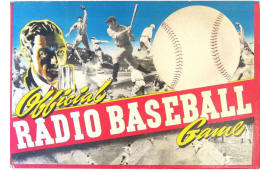 Copyrighted in 1939, by Toy Creations
Inc.,
Official Radio Baseball Game, is
patterned after big league baseball!
Strikes, balls, home runs!
Copyrighted in 1939, by Toy Creations
Inc.,
Official Radio Baseball Game, is
patterned after big league baseball!
Strikes, balls, home runs!
Novel scoring device to accurately record hits, runs, errors, and batting
order of both teams. The game can be
played without the radio, or used while
listening to radio broadcasts.
"As the announcer calls out the lineup and batting orders of the teams,
fill in the card provided for the
purpose. Fit the lineup cards over the
prongs on the score board, set of
indicators to their starting positions
and place the first man on the
"Visitors" at home plate. You are now
ready to follow every play as is
reported over the air, just as if you
were at the field. As each play is
called, move the indicators and keep
score on the score board. The exact
status of the game will be instantly
apparent at all times."
 The
sheet music for "Baseball" (America's
Favorite Game) was published and
copyrighted in 1939 by Words and Music
Inc. The song written by Tom Waring,
Paul Gibbons, & Graig Leitch was
featured and performed by the
Pennsylvanians, on Fred Waring's 15
minute Radio Show, "Chesterfield
Pleasure Time. "Baseball" (America's
Favorite Game) was the first tune Fred
Waring played on the September 30, 1941
for the NBC Network broadcast.
The
sheet music for "Baseball" (America's
Favorite Game) was published and
copyrighted in 1939 by Words and Music
Inc. The song written by Tom Waring,
Paul Gibbons, & Graig Leitch was
featured and performed by the
Pennsylvanians, on Fred Waring's 15
minute Radio Show, "Chesterfield
Pleasure Time. "Baseball" (America's
Favorite Game) was the first tune Fred
Waring played on the September 30, 1941
for the NBC Network broadcast.
The last lines of the song, a far cry from the lyric written for "Take Me
Out to the Ball Game" are "They sell
peanuts and popcorn and cigarettes too,
mostly the brand that we offer to you.
Its Base Ball, Base Ball Americas
Favorite Game."
The white & blue title sheet pictures Fred Waring, with Poley McClintock,
and Paul Douglas gripping the handle of
a baseball bat in a "choosing sides"
manner, all in black & white. Paul
Douglas was the announcer on the radio
show. The back cover features a
Chesterfield Cigarette ad. The inside
of the sheet music at the bottom Reads
"Tune in Fred Waring's "Chesterfield
Pleasure Time" Broadcast Monday's
through Fridays ... NBC Coast-to Coast
Network"
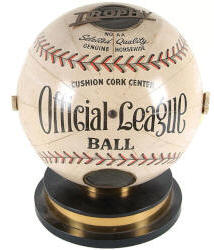 In 1941, Pacific Radio Corporation
produced these Imperial-brand
Trophy
Official League Baseball Radios. They
were made available in the retail
market, but were also used as a
Wheaties Cereal premium.
In 1941, Pacific Radio Corporation
produced these Imperial-brand
Trophy
Official League Baseball Radios. They
were made available in the retail
market, but were also used as a
Wheaties Cereal premium.
In an Economy Stores Baseball Radio Contest featuring Shurefine beverages
and Gold Medal Wheaties. The first 10
persons saving the largest amount of
box tops, and beverage caps, received a
Trophy Baseball Radio.
The next 15 persons saving the greatest amount of box tops and beverage
caps received a Hutch Vince DiMaggio
Fielders Glove. The next 15 persons
saving the greatest amount of box tops
and beverage caps received a
Bob Feller Baseball Bat.
 Charles C. Spink & Son Publisher of The
Sporting News published The Sporting
News Record Book from 1909 to 1948. The
3-by-4.5 inch pocket size booklet
format, basically went unchanged until
1941 with an issue size of 4-by-6.5. In
1942 the 5-by-6.75 inch book was called
the
Official Baseball Record Book.
Charles C. Spink & Son Publisher of The
Sporting News published The Sporting
News Record Book from 1909 to 1948. The
3-by-4.5 inch pocket size booklet
format, basically went unchanged until
1941 with an issue size of 4-by-6.5. In
1942 the 5-by-6.75 inch book was called
the
Official Baseball Record Book.
The 500 page standard edition of the 1942 Baseball Record book, included
World Series summaries and the official
rule book. There was also a 3-page
story on Joe DiMaggio’s hitting streak
of 56 straight in 1941.
The 190 page Radio Edition cover picturing Red Barber, Dodgers radio
announcer, and Bob Elson of Chicago,
primarily focuses on baseball game
information, including schedules,
updates, and radio station listings.
The Sporting News" published a radio edition to cater to the growing
popularity of radio broadcasts for
sports games, allowing fans who
couldn't attend games in person to
still access up-to-date information
about the games through radio,
effectively reaching a wider audience
and maintaining relevance in the
evolving sports media landscape; this
was particularly important for
baseball, which was considered "The
Sporting News'" primary focus at the
time.
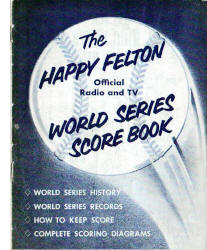 The
Happy Felton Official Radio and TV
World Series Score Book was given
away free by Tydol Flying A Dealers in
1952. The 26 page score book features
14 pages of scorecards, enough to score
a 7 game series.
The
Happy Felton Official Radio and TV
World Series Score Book was given
away free by Tydol Flying A Dealers in
1952. The 26 page score book features
14 pages of scorecards, enough to score
a 7 game series.
The booklet features; World Series results, attendance, receipts and
player share. Year by year major
league; pitching champions, batting
leaders, home rum leaders, and how
Major League teams have finished
1901-1951. A space at the bottom of the
cover is reserved for information of
the Tydol Dealer giving the booklets
away.
The Score book was made to keep score of the World Series while listening
to the game on the radio, or watching
it on TV. Happy Felton host of the Knot
Hole Gang was a TV show that aired on
WOR-TV Channel 9, in the New York area.
The show preceded every Brooklyn Dodger
home game from 1950 to 1957.
 Housed within a wood case, this Roger Maris-Mickey Mantle table Radio
features a molded plastic front
featuring the raised-relief image of a
batter displayed over the "super
Heterodyne speaker" panel. The bat &
embossed baseball tuning dial points to
your favorite AM radio station. Housed within a wood case, this Roger Maris-Mickey Mantle table Radio
features a molded plastic front
featuring the raised-relief image of a
batter displayed over the "super
Heterodyne speaker" panel. The bat &
embossed baseball tuning dial points to
your favorite AM radio station.
The
diamond shaped, on-off knob is
fashioned after a green infield, with
four bases. below is the facsimile
signatures of Roger Maris and Mickey
Mantle. The
Roger Maris - Mickey Mantle
Stellar table radio, Model MM-5, came
in three types of boxes.
One a plain
factory box, another, an orange box
listing the '5 Tube super Heterodyne
radio' specifications, and a picture
with Roger Maris, and Mickey Mantle in
batting poses. The boxes that also
features the M&M boys facsimile
signatures are rare and sells for a
greater premium, than the other two.
 Minneapolis Brewing company, makers of
Grain Belt Beer issued these large
11x18 inch
talking scoreboard radios to
display and distribute to taverns and
restaurants. A bartender would write
live score updates on the acrylic face
of this radio with a grease pencil,
provided with the radio.
Minneapolis Brewing company, makers of
Grain Belt Beer issued these large
11x18 inch
talking scoreboard radios to
display and distribute to taverns and
restaurants. A bartender would write
live score updates on the acrylic face
of this radio with a grease pencil,
provided with the radio.
Minnesota Twin games were broadcast on AM radio station WCCO 830; The
Grain Belt Scoreboard aired on
WDAY-Radio - AM -970 - NBC - 7 times a
day 6 days a week, and KNOX AM radio
1310 in Fargo, North Dakota.
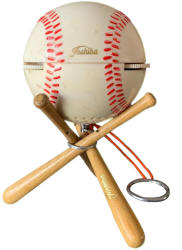 In 1961 Toshiba produced the 6
Transistor model SP-515 Baseball Radio.
The radio looks like and is the same
size as an official big league
Baseball. The baseball radio came
complete with batteries, earphone, and
a 3 bat pedestal.
In 1961 Toshiba produced the 6
Transistor model SP-515 Baseball Radio.
The radio looks like and is the same
size as an official big league
Baseball. The baseball radio came
complete with batteries, earphone, and
a 3 bat pedestal.
Equipped with a caring cord and ring, It could be used two ways ... as a
portable and as a table radio. The
Toshiba SP-515 baseball radio was also
produced with a Minnesota Twins
monogram in 1962. It seems that this
was the only major league produced. The
Twins originally played in Washington,
D.C. before relocating to Minneapolis
in 1961.
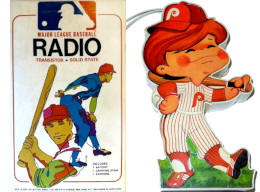 Sutton Associates Ltd.; 200 Fifth
Avenue, New York, NY 10010 was a
Manufacturer, distributor and importer
of merchandising products. In 1974
Sutton produced officially licensed,
Major League Baseball, Transistor Solid
State radios for all 24 teams. Team
insignias were displayed along the
perimeter of the box which housed the
radio.
Sutton Associates Ltd.; 200 Fifth
Avenue, New York, NY 10010 was a
Manufacturer, distributor and importer
of merchandising products. In 1974
Sutton produced officially licensed,
Major League Baseball, Transistor Solid
State radios for all 24 teams. Team
insignias were displayed along the
perimeter of the box which housed the
radio.
As advertised by Mays department store:
YOUR FAVORITE BASEBALL TEAM PORTABLE
RADIO - Pick your winning team from
twenty-four grand-slam winners! Each
radio bears the exclusive licensed
major league baseball insignia of your
favorite team. Each team speaks for
itself, 9" tall, with dynamic 2˝/"
speaker. Includes carrying strap,
earphone, and 9 volt battery. All teams
available.
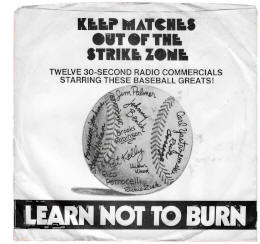 The
"Learn Not To Burn" 33 1/3 RPM record
was a Radio campaign Issued in 1976 by the
National Fire Protection Association,
in cooperation with the Public Service
Council. "Keep Matches Out Of The
Strike Zone" features twelve 30-second
radio commercials staring baseball
greats talking about "Strike Zone."
The
"Learn Not To Burn" 33 1/3 RPM record
was a Radio campaign Issued in 1976 by the
National Fire Protection Association,
in cooperation with the Public Service
Council. "Keep Matches Out Of The
Strike Zone" features twelve 30-second
radio commercials staring baseball
greats talking about "Strike Zone."
There's a "Strike Zone" in every home from the floor to about chest high.
A zone which should never contain
matches or lighters. The "Strike Zone"
is where children spend most of their
time looking for things to do and where
they are apt to find things with which
to start a fire. The "Strike Zone"
public service campaign was aired both
on television and radio by Sports and
entertainment personalities.
The 12 Baseball Greats on the "Keep Matches Out Of The Strike Zone"
Record includes: Wilbur Wood;, Pat
Kelly; Jim Rooker; Richie Zisk; Johnny
Bench; Gary Nolan; Carl Yastrzemski;
Rico Petrocelli; Ferguson Jenkins;
Brooks Robinson; Jim Palmer; and Rich
Gossage.
|
|
| |
|
|
| |
|
|
| |
KEYMAN COLLECTIBLES
RELATED RESOURCES |
|
| |
|
|
| |
|
|
| |
Half the fun of
collecting is showing off your collection to
others. Lets See your Room! |
|
| |
|
|
| |
Showcase
your collection on KeyMan Collectibles for Free!.
Just send pictures, and
Get Your Collectors Showcase Room Now! |
|
| |
|
|
| |
KeyMan
Collectibles Collectors Corner
- Keep up with the latest collecting news,
announcements, and articles of interest on the
webs best resource for baseball memorabilia. |
|
| |
KeyMan Collectibles Baseball
Memorabilia Facebook Group -
Post Questions and comments relating to
Baseball Collectibles and Memorabilia. Interact
with other collectors or show off your
collection. |
|
| |
KeyMan
Collectibles Forum
- A great option for those that "Don't do
facebook" Post Questions and
comments relating to Baseball Collectibles and
Memorabilia |
|
|
|
|
|
|
|

